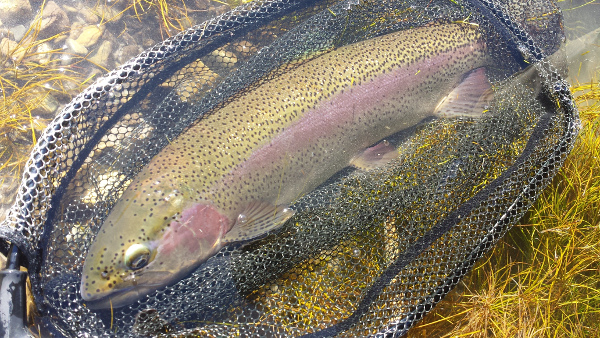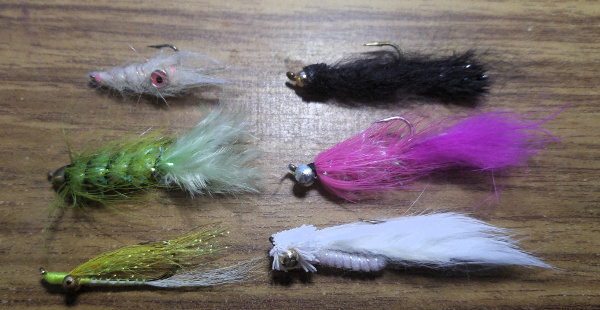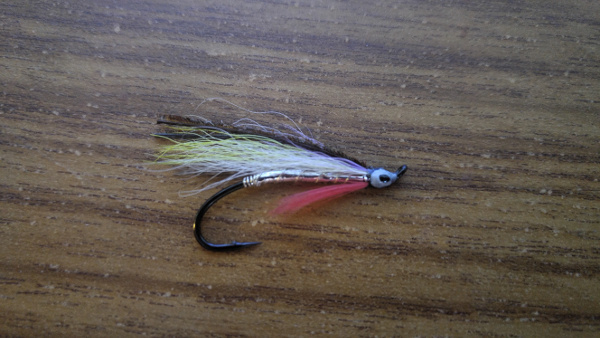
These are a few techniques to use in deep, clear, slow moving pools while fly fishing trout with streamers. These conditions present a unique situation for fly anglers, as trout will behave quite differently from trout found in riffles and other shallow water situations. The deeper water makes the trout feel more secure, and by extension bolder. Trout in deep pools will often be much more eager and reckless when chasing down prey, which makes these conditions perfect for streamer fishing.
Something worth noting is that these techniques are quite different from those needed If you’re fishing in deep, fast moving water (such as spring flooding). Those types of conditions require some very different approaches, as most of the methods listed below rely on the water being relatively slow moving.
Drag the fly
This works best on sandy bottoms and I’ve caught many large steelhead and sea run brookies in the using this method. It is exactly as the title suggestions, you are going to literally drag the fly along the bottom. I find this fly fishing technique works particularly well in heavily fished waters with pressured, picky trout.
I use this technique in areas where there are lots of critters crawling along the riverbed, like caddisfly larva, crayfish, or sand shrimp. You are trying to mimic a prey items movements as they slowly crawl along the bottom. You do this by making *painfully*(I can’t stress this enough) slow, long strips to retrieve the fly. Keep in mind how quickly the forage species your mimicking move along the bottom of the river, this should be the speed of your retrieve. If the fishing is slow, catch the trouts attention by throwing in the odd twitch every once in a while to mimic a shrimp getting spooked, or a nymph getting dislodged.
Not surprisingly, shrimp streamer patterns work well for this method. This technique is not just limited to streamers, try using a nymph pattern such as a hares ear or pheasant tail to mimic a nymph crawling along the bottom. Whatever pattern you choose, it’s best to use a variant of the fly that rides hook up since it’s being dragged along the bottom (dumbbell eyes are the way to go!) A clouser minnow or a crayfish pattern are also good choices for fishing this style.

From my limited knowledge on largemouth and smallmouth bass fishing, I’d imaging this method would be effective for them in addition to trout, as they are well known to love to pick crayfish off the bottom.
Jig the fly
This method borrows a technique commonly used by striped bass spin anglers targeting striped bass on the bottom with big bucktail jigs. You are going to use a front heavy fly such as a clouser minnow, a large bead head streamer, or even a micro jig.
You want to make a series of short, rapid strips when retrieving the fly. The goal is to bounce the fly just off the bottom as you retrieve it. Jigging the fly in this way allows you to keep the fly in the strike zone. It’s very easy to tell when you hit bottom using this method, at which point you will have to strip more quickly to keep it off the bottom.
If you have a hard time keeping the fly off the bottom, switch to a lighter fly. The opposite true if you can’t get the fly down, switch to a heavier fly.
Count Down
You know you have to get deep, but how do you know when your fly is deep enough? The count down trick has been around for a while, and it’s the simplest way of knowing how deep your fly is. Drop the fly into the water beside you, and count as you take note of how quickly the fly sinks. Now you have an idea of how quickly your fly sinks per second. If you’re casting to a hole that is 12 feet deep, you can now count down how many seconds it takes for the fly to approach the bottom before beginning your retrieve.
Keep in mind that your fly line, leader, and current of the river will all affect the sink rate of your fly, this method just gives you a rough idea to start the trial and error process to get the fly to the right depth.
If you buy anything below, I get a bit of beer money (commission).
Swing and suspend the fly
Swinging streamers is a classic technique with good reason, it works! The specific method of swinging streamers I’m talking about here uses a weightless fly, and thus requires a sinking tip fly line. The technique involves casting the fly out perpendicular, or perhaps slightly upstream of the current and allowing the sinking line to bring the fly down into the strike zone, you are then going to slowly strip the fly back to you. The idea is to have the fly suspended a few feet above the river bottom.
While some of the other methods listed will catch trout looking at the river bottom, many trout are looking upwards, even in a deep pool. This presentation will swing the fly right over their noses, mimicking an unaware baitfish. This is a great searching technique, and will allow you to work the entire pool very quickly.

GinkandGasoline.com does a good job of explaining a very similar technique here.
The best flies to use for this are weightless flies with a slim profile to cut down on drag. The weightlessness of the fly allows it to be suspended in the middle of the water column, while the slim profile still allows it to cut through the water and get down into the strike zone quickly when you’re not retrieving it. The classic Mickey Finn is a great fly choice for fishing this way.
Make the fly jump
This is a technique I often employ when I’ve been fishing deep. It’s a last ditch effort at the end of a retrieve to entice a following trout to strike the fly, and it works frequently enough that I make a point of doing it most of the time. After working the the fly along the bottom, many times you’ll have a trout following the fly that has so far not committed to a strike. Near the end of the retrieve, make a series of sharp, quick, and long strips. The goal is to make the fly quickly dart or jump off the bottom like a bait fish or shrimp fleeing the trout in pursuit. This will often trigger the trout to strike. Be ready because I’ve had some extremely aggressive takes using this method just a few feet infront of me. I love when this technique works because you get to actually see the trout slam the fly.
This technique seems to be especially effective when the fly is leaving deep water to enter much shallower water (usually where you’re wading). I suspect this is because many bait fish will flee to shallow water to escape a predator.

I’ve not fished streamers much because I’ve never had much luck with streamers. I’m going to take this crash course and give it a try next spring.